

Fundraiser by Chloe Schempf : TSI Filter Media Research - Michigan Mask Response. The materials that filter particles best in homemade masks via testing. Coronavirus: household cleaning products can kill the virus – an expert on which ones to use. It’s easy for an infected person to spread the virus particles through coughing, touching other people or leaving the virus on surfaces.

Undoubtedly, hand-washing after being in public spaces is key to reduce the spread of COVID-19. But what should we be doing in our homes to eliminate it? Two recent studies have investigated how long coronaviruses survive on different surfaces. The research looked at a number of different viruses including SARS-CoV-2 – the coronavirus that has caused COVID-19. And it found that the survival times varied according to the type of surface. The amount of virus particles during this time does reduce, but it’s worrying that the particles can last for days rather than hours or minutes on a surface. Material Filter Testing. N95 Material Part 3: The Platypus Mask.
3 Easy DIY Mask Tests - MakerMask. COVID-19 is primarily transmitted via respiratory droplets.
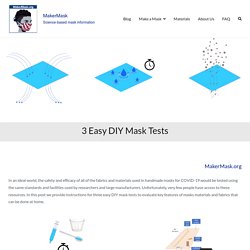
Face masks for COVID -19 are designed to cover the mouth and the nose and act as a barriers to droplets to help reduce the spread of COVID-19. Although these fabric masks are intended for use as source control to contain users droplets (i.e. egress of droplets) some designs, such as those with water-resistant outermost layers, may help keep droplets from the outside world to the users mouth and nose (i.e. ingress of droplets). The three key requirements for Masks for COVID-19 are: water resistance, breathabilty, and filtration. Water Resistance: Materials can be characterized by whether they repel water (hydrophobic) or attract water (hydrophilic).
Hydrophobic materials can be used to help act as barriers to liquids like droplets. Making a homemade COVID mask? Study explains best fabric choices. Editor’s note: Health authorities believe COVID-19 spreads by the transmission of respiratory droplets, and the Centers for Disease Control and Prevention recommends homemade cloth face coverings for use in public spaces.
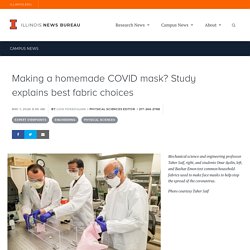
Starting today, Illinois joins many other states in requiring people to wear masks while out. However, initial uncertainty regarding the masks’ effectiveness in reducing exhaled droplets leaves some people unsure or skeptical of their usefulness during the current COVID-19 pandemic. Mechanical science and engineering professor Taher Saif spoke with News Bureau physical sciences editor Lois Yoksoulian about a study that he and his graduate students, Onur Aydin and Bashar Emon, performed on the effectiveness of common household fabrics for use in homemade masks. Physically speaking, are the respiratory droplets produced by talking and breathing the same as those that come from a cough or a sneeze?
What fabric properties did you test? New Research Shows Electroceutical Fabric Eradicates Coronavirus Infectivity On Contact. In the fight against Covid-19, protective personal equipment has played a central and critical role for the safety of healthcare workers.
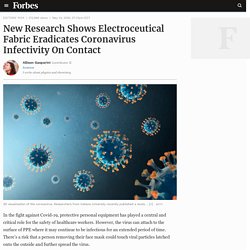
However, the virus can attach to the surface of PPE where it may continue to be infectious for an extended period of time. There’s a risk that a person removing their face mask could touch viral particles latched onto the outside and further spread the virus. A preprint paper published recently by scientists from Indiana University suggests a fabric which eradicates the infectivity of coronaviruses on contact by generating an electric field could be the answer to the problem.
Last month, a team of researchers determined a hybrid combination of one layer of cotton and two layers of chiffon is the most effective fabric for a face mask. What we’ve learned after making 167,000 masks!!! Untitled. COVID 3D Printed Mask Frame for Halyard, Investigating 99% Filtration.
Yang Wang – PMTL – Missouri University of Science and Technology. Hospitals Turn to Researchers for Mask Efficacy Answers - UNC Research. A major concern within the COVID-19 outbreak is hospitals’ supplies of personal protective equipment (PPE).
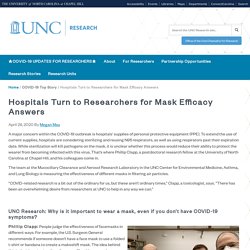
To extend the use of current supplies, hospitals are considering sterilizing and reusing N95 respirators, as well as using respirators past their expiration date. While sterilization will kill pathogens on the mask, it is unclear whether this process would reduce their ability to protect the wearer from becoming infected with this virus. That’s where Phillip Clapp, a postdoctoral research fellow at the University of North Carolina at Chapel Hill, and his colleagues come in. The team at the Mucociliary Clearance and Aerosol Research Laboratory in the UNC Center for Environmental Medicine, Asthma, and Lung Biology is measuring the effectiveness of different masks in filtering air particles.
“COVID-related research is a bit out of the ordinary for us, but these aren’t ordinary times,” Clapp, a toxicologist, says. Assessment of Fabric Masks as Alternatives to Standard Surgical Masks in Terms of Particle Filtration Efficiency. Assessment of Fabric Masks as Alternatives to Standard Surgical Masks in Terms of Particle Filtration Efficiency. (PDF) A cluster randomised trial of cloth masks compared with medical masks in healthcare workers. Grant; however they were not involved in study design, data collection or analysis.
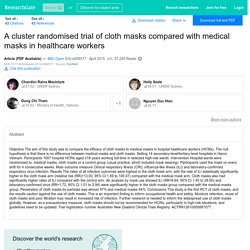
The 3M products were not used in this study. Contributors CRM was the lead investigator, and responsible for the conception and design of the trial, obtaining the grant funding, overseeing the whole study, analysing the data and writing of the report. Contributed to overseeing the study, staff training, form/database development and drafting of the manuscript. Overseeing the study, database management, recruitment, training and revision of the manuscript. KC7568. KLUDE WYPALL 1-LAGS X80 BLÅ 240 ARK. The best material for homemade face masks may be a combination of two fabrics. “Aerosol Filtration Efficiency of Common Fabrics Used in Respiratory Cloth Masks”ACS Nano In the wake of the COVID-19 pandemic, the U.S.
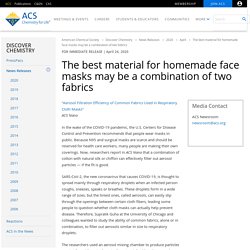
Centers for Disease Control and Prevention recommends that people wear masks in public. Because N95 and surgical masks are scarce and should be reserved for health care workers, many people are making their own coverings. Now, researchers report in ACS Nano that a combination of cotton with natural silk or chiffon can effectively filter out aerosol particles — if the fit is good. Choice page. COVID-19 protection, PPE reuse and DIY: annotated resource list.
FILTER. NÆSEKLEMMER. Autoclavable Blue Wrap Halyard Masks - Mending Souls — Mending Souls. Your 10 minutes can save a life.
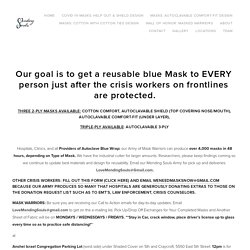
EMAIL US to find out when is the next drop-off/pick up DRIVE-thrus for REPURPOSED, “Autoclavable blue wrap” fabric for masks. These are for OUR heroes during the shortage of N95 masks. WE ENCOURAGE SEWING GUILDS IN EVERY CITY TO CALL LOCAL HOSPITALS TO DO SAME with this material in every hospital! The Mending Souls Army broke their record again and dropped off 4,071 MASKS for our local hospitals in ONE DAY (April 6th, 2020). If you have a sewing machine = SEW a mask in 10 minutes, INCLUDING 5 minutes to cut. Email: LoveMendingSouls@gmail.com to Join the ARMY making these for those risking their lives every day. Please pass on -- doing our part to protect the doctors, nurses, and all caretakers who are risking their lives on the frontlines of this pandemic. IF you are able to SEW or CUT out the mask pattern below, PLEASE: YOU ARE NEEDED, to donate sewing, cutting time, thread, or any change will help cover costs during this time when they need us most.
P.S. Can DIY face masks help Tucson medical professionals during the COVID-19 pandemic? Everything you need to know. Editor's note: This story was up-to-date at the time of publication on March 26, but because this is an ever-changing situation, you should check with individual hospitals, the Centers for Disease Control and Prevention and the Pima County Health Department for updated information.
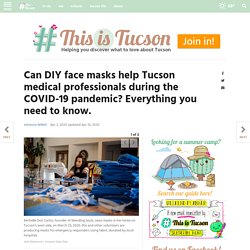
We also wanted to let you know that on April 3, President Trump announced that the CDC is recommending that people wear fabric face masks when in public. This is a change from previous guidance that said healthy Americans did not need to wear face masks. The change comes as recent studies show that individuals with no COVID-19 symptoms can still spread the disease to others. Wearing a cloth face mask may prevent people who have the virus but don't know it, from infecting others. Wearing a mask in public is voluntary and does not replace social distancing. Partikelanalyser og partikelkarakterisering - Partikler i luft - Ydelser - Teknologisk Institut. Tools for Fabric Mask Makers - Appropedia: The sustainability wiki. We continue to develop resources related to the COVID-19 pandemic.
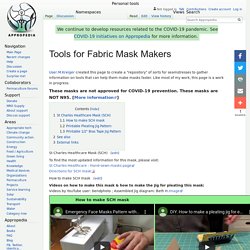
See COVID-19 initiatives on Appropedia for more information. Tools for Fabric Mask Makers. Laser welding and cutting synthetic non-woven fabrics. by +ctc. Non-woven materials are frequently used for the production of disposable medical personal protective equipment (PPE) like face masks or disposable aprons, coveralls, or shoe covers. The term non-woven is used in the textile manufacturing industry to denote engineered fabrics which are neither woven nor knitted. They are made from staple fibre (short) and long fibres (continuous long), bonded together by chemical, mechanical, heat or solvent treatment.
Quick Tip: Working With PUL (Polyurethane Laminate) - Sew4Home. What is soft, pliable, and waterproof; can withstand fairly high temperatures; and holds up to a lot of use? Like me, your first guess might have been those dang swimming pool noodles you always buy too many of and then never know what to do with once summer is over. But… the real answer is: PUL, polyurethane laminate if you wish to be formal. The broad category refers to any fabric with a polyurethane laminated to a base fabric. Most common is a polyester knit fabric laminated to a thin waterproof, non-breathable polyurethane backing. Originally developed for use in the medical industry, it’s very durable and very popular right now for folks making diapers, diaper covers, changing pads, bibs, training pants, and outside the world of babies, it’s often used to create reusable sandwich, snack and lunch bags.
We chose the thin, 1.33 mm PUL knit as a waterproof lining for our Baby Gifts: Pretty Bird Quick Trip Diaper Bag. Feet. Using blue shop towels in homemade face masks can filter particles 2x to 3x better than cotton, 3 clothing designers discover after testing dozens of fabrics. Lindsay Medoff, the CEO of Suay Sew Shop, a 30-employee boutique Los Angeles clothing manufacturer, wants the armies of people sewing homemade surgical masks to add a specific blue shop towel inside them.Medoff and two friends were appalled by the dozens of mask patterns calling for cotton, a highly breathable, permeable fabric, and became obsessed with finding a fabric better suited for the job.
The US boutique clothing manufacturing industry is abuzz as sewing shops retool themselves into surgical-mask-making factories, like something out of a World War II "it's up to you"-style poster. Lindsay Medoff, the CEO and owner of Suay Sew Shop, a 30-employee boutique manufacturer in Los Angeles, has eagerly jumped on board. Jo Montana - Another reason why I use t-shirt straps... FIT-TEST af åndedrætsværn. Quantitative Respirator Mask Testing of HVAC Filters, Baby Wipes, Paper Towels, Coffee Filters. Facemask wires,filters and materials - blackstepsblacksteps.
Updated 10:58 PM April 9 Complete list of open source and DIY plans for masks, 3D printing and ventilators and more is here. I am working on many blog posts like this at once, and the following is not yet as organized as it will be. University of Tennessee Research Foundation. Article originally published March 25, 2020. Article by Dr. Peter P. Tsai, UT Knoxville research professor and inventor of the electrostatic charging technology that makes the filter media of face masks including medical and N95.
Dr. Tsai is a material scientist not a virologist and as such his advice is on possible sterilization techniques and how the materials perform. Abstract Medical masks and N95 respirators are widely used to protect against airborne diseases such as tuberculosis, SARS, MERS, avian and swine flues, and the recently emerged COVID-19. The Big Four: Criteria for Community Mask Materials - MakerMask. Dry heat is not recommended for MakerMask designs. Although some studies have shown that particle filtration efficiency remain OK with that dry heat at temperatures of 70°C for 30 minutes, the effectiveness of that temperature and duration of dry heat is less clear.
University of Tennessee Research Foundation. Dr. Peter Tsai, inventor of the electrostatic charging technology that makes the filter media of face masks including medical and N95, was recently featured in this article from the Washington Post, which provides various sources and opinions on constructing DIY face masks. What’s the Best Material for a Mask for Coronavirus? Face mask filter materials – what can we use for DIY face masks? – Tiana's Closet.
Testing Shows Type of Cloth Used in Homemade Masks Makes a Difference, Doctors Say. Homemade masks can play an important role in the fight against the COVID-19 pandemic but the type of fabric used is key to their effectiveness, according to tests performed at Wake Forest Baptist Health. In an effort to determine the protective qualities of homemade cloth masks, a team of doctors and scientists used rigorous testing, known as particulate filtration, to evaluate 13 different designs from approximately 400 masks made by community volunteers. DIY Cloth Face Mask : 9 Steps (with Pictures) - Instructables. UF Health anesthesiology team devises respirator mask made from existing hospital materials. With respiratory masks used by health workers battling the coronavirus in short supply, the University of Florida Health’s department of anesthesiology has developed masks that can be produced in large quantities using materials already found in hospitals and medical facilities.
What’s the Best Material for a Mask for Coronavirus? Why the best material for a homemade coronavirus face mask is hard to identify. Credit: Shutterstock. In Search of a Performing Seal: Rethinking the Design of Tight-Fitting Respiratory Protective Equipment Facepieces for Users With Facial Hair. People are making DIY face masks amidst shortages due to coronavirus. An Alternative Design. Sewing Masks from Blue Sterile Wrap.